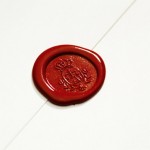by Edward Clowney – servant of Jeroboam.” Recovered from the biblical site of Megiddo, the stamp seal was once the property of an official of Jeroboam II, king of Israel, 785–743 B.C.(2 Kings 14:23– 29). Shema may have been proud of his lion-seal, but for him it was not a decorative gemstone. Rather, he put it to daily use. Pressed on clay or wax it marked his ownership and authority. Wine jars, stoppered with fresh clay, would bear the stamp of his seal. He could seal a deed of purchase or a marriage contract; his stamp could serve as his signature.
Seals and sealing are often spoken of in the Old Testament: Queen Jezebel used Ahab’s seal to order a conspiracy against the life of Naboth (1 Kings 21:8); Queen Esther delivered the Jews when she was permitted to prepare a royal decree and seal it with the king’s ring—“for no document written in the king’s name and sealed with his ring can be revoked” (Esther 8:8).
The apostle Paul grasped this image to describe the sealing of the Lord: “Having believed, you were marked in Him with a seal, the promised Holy Spirit, who is a deposit guaranteeing our inheritance until the redemption of those who are God’s possession—to the praise of His glory” (Ephesians 1:13b–14). Continue reading →

